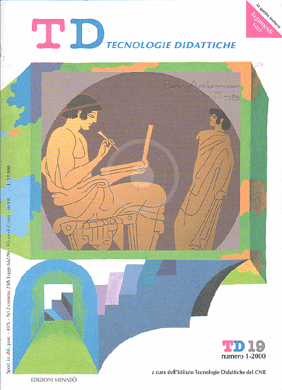Educational proposals around a body of texts
Main Article Content
Abstract
Article Details
Authors who publish with this journal agree to the following terms:
- Authors retain copyright and grant the journal right of first publication with the work simultaneously licensed under a Creative Commons CC BY 4.0 Attribution 4.0 International License.
- Authors are able to enter into separate, additional contractual arrangements for the non-exclusive distribution of the journal's published version of the work (e.g., post it to an institutional repository or publish it in a book), with an acknowledgement of its initial publication in this journal.
- Authors are permitted and encouraged to post their work online (e.g., in institutional repositories or on their website) prior to and during the submission process, as it can lead to productive exchanges, as well as earlier and greater citation of published work (See The Effect of Open Access)
References
Bereiter C. & Scardamalia M. (1996), Rethinking Learning, in Olson D. & Torrance N. (eds.), The Handbook of Education and Human Development, MA: Blackwell, Malden.
Bereiter C. (2000) (in progress), Education and Mind in the Knowledge Age, disponibile solo on-line (http://csile. oise.utoronto.ca/edmind/ edmind.htlm)
Caviglia F., Earp J., Ferraris M. (1996), From Italian (L1) to English (L2) WordProf: an instructional software for teaching writing, in 1996 European Writing Conferences. - EARLI Special Interest Group Writing, Barcelona, 23-25 October 1996; ISBN 84-88795-36X.
Caviglia F., Sarti L. (1989), Intelligenza artificiale: quale contributo all’educazione linguistica?, in Calvani A. (ed.), Scuola, computer, linguaggio, Loescher, Turin, pp. 101-159.
Ferraris M, Caviglia F., Degl’Innocenti R.. (1990), WordProf: a writing environment on computer, in Hartley W. (ed.), Technology and Text: Readings in the Psychology of Written Communication, Jessica Kingsley Ltd., London/Philadelphia, 1992 [pubblicato originariamente in Educational Technology and Training International (ex “PLET”), February 1990, pp. 33-42].
Geist U. (1996), Imitation as a tool in writing pedagogy, in Rijlaardsam G., Van den Bergh H. & Couzijn M. (eds.), Effective Teaching and Learning of Writing, Amsterdam University Press, Amsterdam, pp. 51-60.
Haarstrup K. (1991), Lexical Inferencing Procedures or Talking about Words, Gunter Narr, Tübingen.
Johns T. (1988), Whence and Whither Classroom Concordancing?, in T. Bongaerts et al. (eds.) Computer Applications in Language Learning, Foris, Dordrecht.
Murison-Bowie S. (1996), Linguistic corpora and language teaching, in Annual Review of Applied Linguistics, n. 16, pp. 182-199.
Oostdam R., Rijlaardsam G. (1995), Toward Strategic Language Learning, Amsterdam University Press, Amsterdam.
Stevens V. (1995), Concordancing with Language Learners: Why? When? What?, in CAELL Journal, vol. 6, n. 2, pp. 2-10 (http://www.ryf.rice. edu/-barlow/stevens. html).
Tornatore L., (1989), XXX, in Calvani A. (ed.), Scuola, computer, linguaggio, Loescher, Turin, pp. 101-159.
Tribble Ch. & Jones G. (1990), Concordancing in the classroom, Longman, Harlow, Essex (new edition: Concordances in the classroom: a resource book for teachers, Athelstan 1997).
Weinrich H. (1983), Vers la constitution d’une competence interrogative, in Zielsprache Französisch, n. 2, 1983, pp. 57-64 (tr. it. in Weinrich H., Vie della cultura linguistica, Il Mulino, Bologna, 1989)

